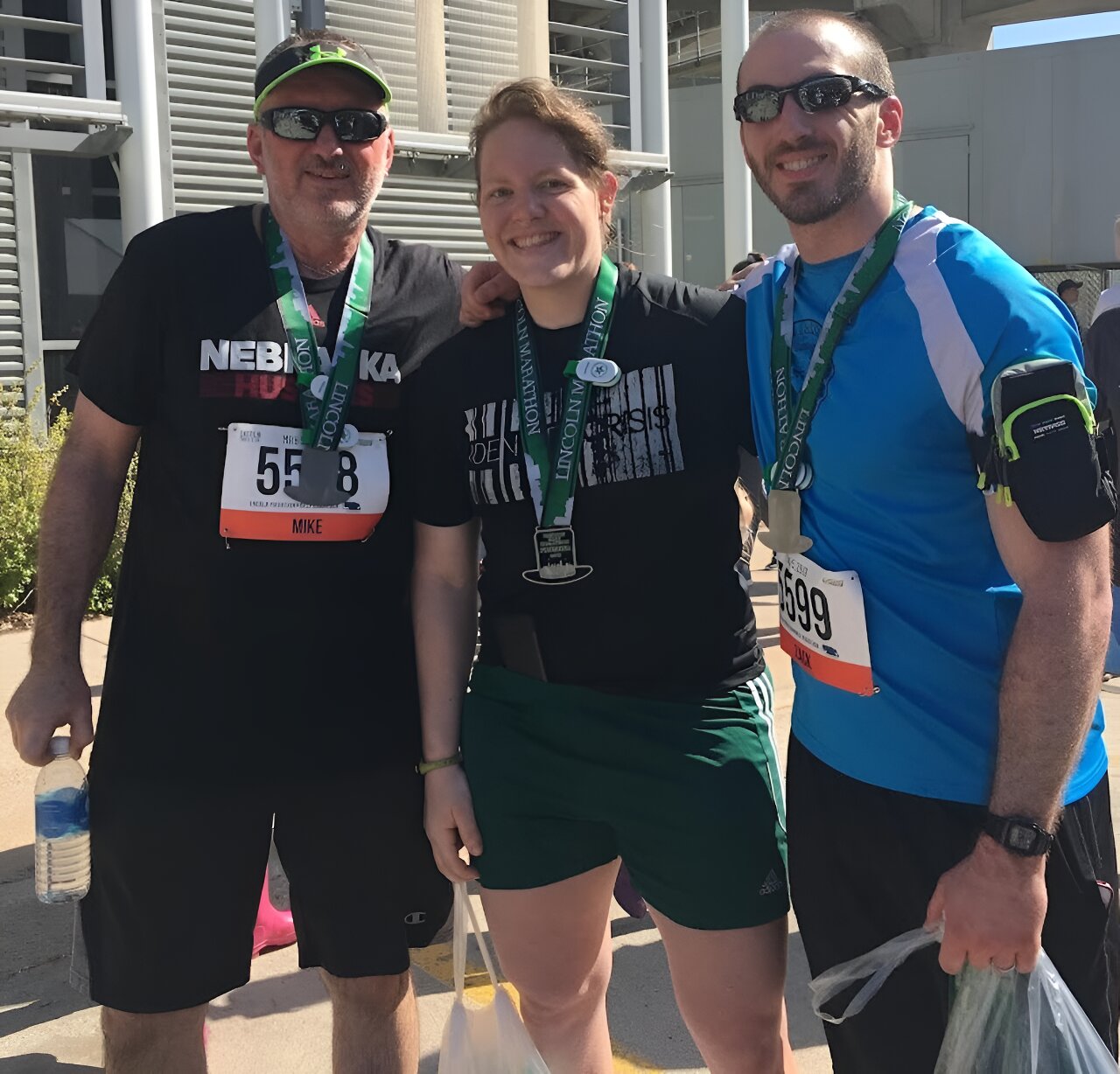× close
From left are the author’s father, then 61 years old, the author’s wife, and the author after completing the Lincoln Half Marathon. Photo credit: Zachary Gillen, CC BY-NC-ND
Raise your hand if you often find yourself climbing stairs. What about carrying heavy grocery bags? What about picking up your children or grandchildren? Most of us would raise our hands to do at least one of those things weekly, or even daily.
As people age, it can become increasingly more difficult to perform certain physical tasks, even the normal activities of daily life. However, prioritizing fitness and health as you age can help you carry out normal daily activities without feeling physically exhausted at the end of the day.
It can also help you continue to make special memories with your family and loved ones that you might not have had without physical activity. For example, I ran two half marathons with my dad when he was in his 60s!
I’m an exercise physiologist who studies how people can use resistance training to improve human performance, whether it’s in sports and other recreational settings. , in everyday life or both. I am also a certified strength and conditioning specialist. My career has given me the opportunity to design exercise programs for children, college athletes, and older adults.
Staying physically active as you age doesn’t have to include running a half marathon or trying to become a bodybuilder; it could be as simple as trying to get through the day without feeling tired after climbing the stairs. Although our muscles naturally weaken as we age, there are ways we can combat that to help improve our quality of life as we age.
Muscle loss and chronic disease
One of the most important parts of an exercise program, no matter who I’m working with, is proper resistance training to build muscle strength. Some degree of age-related loss of muscle function is normal and unavoidable. But by incorporating appropriate and safe resistance training at every ability level, you can slow the rate of decline and even prevent loss of some muscle function.
The medical term for a condition related to age-related loss of muscle function and mass is sarcopenia. Sarcopenia can begin as early as age 40, but it tends to be more common in adults 60 and older. Sarcopenia is associated with a number of health problems such as increased risk of falls, cardiovascular disease and metabolic disease, among others.
× close
Typical age-related changes in muscle strength and size with and without strength training. Credit: Zachary Gillen
In one of our group’s previous studies, we found that healthy people with sarcopenia had problems delivering key nutrients to their muscles. This can lead to a greater likelihood of various diseases, such as Type 2 diabetes, and slow recovery after exercise.
Recent estimates suggest that sarcopenia affects 10% to 16% of the elderly population worldwide. But even if a person is not clinically diagnosed with sarcopenia, they may still have some underlying symptoms that, if left untreated, can lead to sarcopenia.
Strength training is key
So the question is, what can be done to reverse this decline?
Recent evidence suggests that one of the main factors leading to sarcopenia is low muscle strength. In other words, combating or reversing sarcopenia, or both, may be best accomplished with an appropriate resistance training program that prioritizes strength improvement. In fact, the decline in muscle strength appears to occur at a much faster rate than the decline in muscle size, which highlights the importance of appropriate strength training as people age. Go.
Continued regular strength training with moderate to heavy weights has been shown to be not only effective in combating the symptoms of sarcopenia, but also very safe when done properly. The best way to ensure you are strength training properly is to seek guidance from a qualified individual such as a personal trainer or strength and conditioning specialist.
Despite the clear benefits of strength training, it has been shown that only about 13% of Americans aged 50 and older perform some form of strength training at least twice a week.
× close
Credit: The Conversation
Find what works for you
So how does one properly train for strength as they age?
The National Strength and Conditioning Association, a leading organization in promoting strength and conditioning worldwide, states that for older adults, strength training two to three days per week can Extremely helpful for maintaining healthy muscles and bones as well as fighting several chronic diseases. condition.
The organization recommends that these workouts include one to two exercises that involve multiple joints for each major muscle group, with six to 12 repetitions per set. They are performed at an intensity between 50% and 85% of your one-rep maximum – the highest amount of weight you can handle in one repetition, with the exception of weight-bearing exercises. the body uses its own body weight as resistance, such as in push-ups.
I also recommend resting about two to three minutes between sets, or even up to five minutes if the set is difficult. For older adults, especially those 60 and older, National Strength and Conditioning Association guidelines suggest that a program like this should be done two to three days per week, with 24 to 48 hours between workouts.
Make life tasks easier
The instructions above are just one example of many options, but they provide a framework you can use to build your own program. However, I strongly recommend that you seek out an expert in this field to provide specific advice on an exercise program that may suit your own needs and goals as you age.
Following such a program will give your muscles an excellent stimulus for strengthening, while also allowing for sufficient recovery, something that is very important as people age. You might think it looks like a huge time commitment, but an exercise routine like this can be done in less than an hour. This means that with as little as three hours of strength training per week, you can help improve your muscle health and reduce your risk of sarcopenia and related health problems.
It’s important to note that there is no right way to do resistance training, and it doesn’t require traditional weight equipment. Group classes like Pilates and yoga or those that involve circuit training and resistance band activities can yield similar results. It’s important to get outside and exercise regularly, no matter what that entails.
#Strong #physical #decline #age #inevitable #Heres #strength #training #change #trajectory
Image Source : medicalxpress.com

